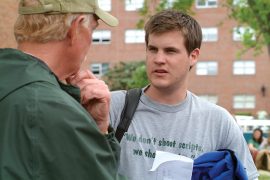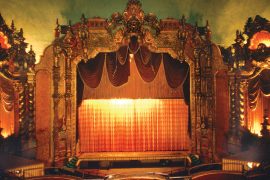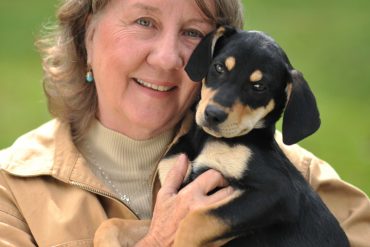Meet the man who played a key role in building Huntington’s South Side
By James E. Casto
HQ 67 | WINTER/SPRING 2009
During Huntington’s first decades, nearly all its residents lived in the narrow strip of land between the Ohio River and the Chesapeake & Ohio Railway tracks.
Until after World War I, much of the property south of the C&O tracks was open country, with only a house here and there. Indeed, when the old Huntington High School was built on 8th Street between 9th and 10th avenues in 1916, some complained that it was “too far out of town.”
But as Huntington grew, what became known as the South Side evolved into one of the city’s premier residential neighborhoods. And one of those who played a key role in making that happen was Azel Meadows.
In his long and busy real estate career, Meadows built more than 1,000 of Huntington’s finest houses. Many of those were on the South Side, but his handsome handiwork can still be seen in many other neighborhoods as well. He is also remembered for donating the land for Meadows Elementary School, which accordingly was named in his honor, and for the former Sunset Chapel Missionary Baptist Church.
According to information provided by his daughter, Esthel America Meadows Pennington, Meadows was born in 1882 at Glenwood in Mason County, the son of F.M. Meadows and Cora Bell McCurdy Meadows.
Meadows went to Marshall College from 1902 to 1904. His first job was with the Adams Express Freight Co. He left Adams to take a job with the Post Office, where he worked for 10 years. It was during this time that he grew interested in real estate and even made a few sales before leaving the Post Office.
In 1914, he struck out on his own, buying property and building houses in many areas of Huntington.
Some of the streets and neighborhoods where he built include Belford Avenue, Crestmont Drive, Wilson Court, Beverly Hills, North Terrace, Green Oak Drive and Pea Ridge Road, as well as Wiltshire, Enslow and Washington boulevards.
At one point Meadows advertised that he built “One New Home Each Week.” All were “Sold on Easy Terms,” he added.
He built many homes in the Highlawn area of East Huntington, and most of those are still lived in today. At 3rd Avenue and 24th Street he built Crystal Pool, said to be the first swimming pool in Huntington. Just a block away, he erected the city’s first gas station.
He sold lots in Guyandotte and built many of the houses on Ohio River Road. The largest of these, Meadows Heights, was built for his parents. He developed Greenbottom Cemetery on Ohio River Road and Woodmere Cemetery on Washington Boulevard.
Meadows married his wife, the former Esthel Caroline Dunfee, in 1919, and the two worked side by side in the business. When the stock market crash of 1929 triggered the Great Depression, he and his wife lost virtually everything they had and were forced to take bankruptcy.
“But they didn’t give up. They simply started over again,” says Mrs. Pennington.
After World War II, Meadows became interested in rural property and tracts of land that he could develop into five and 10-acre parcels that he called “baby farms.” These were in the Blue Sulphur and Howells Mill area east of Huntington. The site of Camp Arrowhead, the Tri-State Area Council Boy Scout Camp near Blue Sulphur, was purchased from Meadows.
Meadows was a member of the Fifth Avenue Baptist Church, which in the 1920s established the Sunset Chapel Missionary Baptist Church at 4895 Ohio River Road.
Karl Schoew, a prominent Huntingtonian who lived nearby, persuaded Meadows to donate the property for building the missionary church. Schoew then paid half the cost of constructing the church – even though he belonged to another congregation. The church’s name came from the fact that Ohio River Road originally was known as Sunset Drive, the name the Schoews gave the road when they moved there.
Sunset Church thrived from many years. In the late 1950s, it had 200 members and an average Sunday morning attendance of 130. It even sponsored Boy Scout and Cub Scout troops. But like many other small churches, it saw its membership dwindle over the years. By 2004, its weekly attendance had shrunk to about 10 people and it was forced to close its doors.
In 1939, Meadows Elementary School opened at Washington Boulevard and 16th Street (now Hal Greer Boulevard), built on a site donated by Meadows.
“He believed that if a town was going to grow it needed schools and churches,” explains his daughter.
Meadows was a member of the Huntington Chamber of Commerce, the Huntington Kiwanis Club and the Huntington Board of Realtors. A 32nd degree Mason, he was a member of Beni Kedem Temple of the Shrine at Charleston.
He built his last house – fittingly enough, on the South Side – in 1949.
Dave Gideon, the publisher of The Herald-Dispatch, and Meadows were friends for many years, and the two partnered together on a number of real estate ventures, including the development of Woodmere Cemetery. When Gideon died in 1950, Meadows lamented that he had lost his “best friend.”
Meadows suffered a heart attack in June 1950, which forced him to close his real estate business. He died August 11, 1952, after suffering another heart attack at his home.





